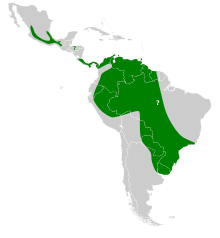| Brazilian brown bat | |
|---|---|

| |
| A preserved Eptesicus brasiliensis specimen | |
| Scientific classification | |
| Domain: | Eukaryota |
| Kingdom: | Animalia |
| Phylum: | Chordata |
| Class: | Mammalia |
| Order: | Chiroptera |
| Family: | Vespertilionidae |
| Genus: | Eptesicus |
| Species: | E. brasiliensis
|
| Binomial name | |
| Eptesicus brasiliensis Desmarest, 1819
| |

| |
The Brazilian brown bat (Eptesicus brasiliensis) is a bat species from South and Central America.
Description[edit]
The Brazilian brown bat is medium in size, being 85–91 mm (3.3–3.6 in) long, and has forearms that are 41–47 mm (1.6–1.9 in) long.[2] It has a long tail and triangular ears.[3]
Habitat[edit]
The Brazilian brown bat is found in forests and forest edges, primarily near sources of water like streams and rivers. They roost in hollow trees and houses.[2][3]
References[edit]
- ^ Barquez, R.; Perez, S.; Miller, B.; Diaz, M. (2016). "Eptesicus brasiliensis". IUCN Red List of Threatened Species. 2016: e.T7916A22114459. doi:10.2305/IUCN.UK.2016-1.RLTS.T7916A22114459.en. Retrieved 8 January 2023.
- ^ a b Bats of Colima, Mexico. Animal natural history series. Norman: University of Oklahoma press Sam Noble Oklahoma museum of natural history. 2016. pp. 186–187. ISBN 978-0-8061-5216-5.
- ^ a b Reid, Fiona (2009). A field guide to the mammals of Central America & Southeast Mexico (2nd ed.). Oxford ; New York: Oxford University Press. p. 157. ISBN 978-0-19-534322-9. OCLC 237402526.

Well, that’s interesting to know that Psilotum nudum are known as whisk ferns. Psilotum nudum is the commoner species of the two. While the P. flaccidum is a rare species and is found in the tropical islands. Both the species are usually epiphytic in habit and grow upon tree ferns. These species may also be terrestrial and grow in humus or in the crevices of the rocks.
View the detailed Guide of Psilotum nudum: Detailed Study Of Psilotum Nudum (Whisk Fern), Classification, Anatomy, Reproduction